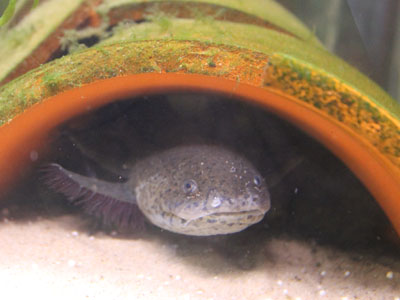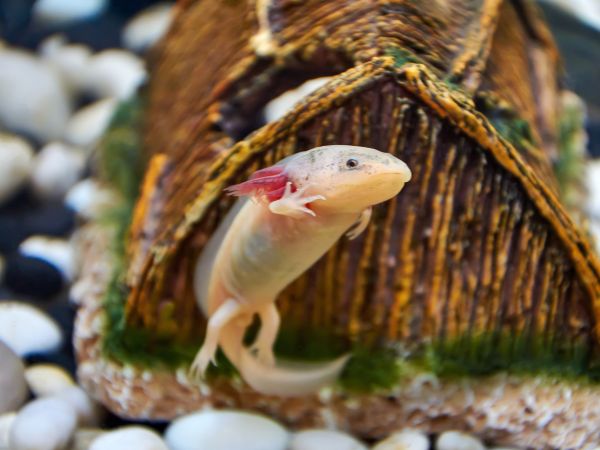One of the most common questions that axolotls ask is whether axolotls shed their skin, and what type of skin they have. If they see their axolotls shedding their skin, they start panicking and worrying whether their axolotls are sick.

The truth is that they will shed their slime coat, not their skin. And that is an indicator that there is something wrong with the water or the conditions in the tank. Most commonly, the water parameters are wrong, especially the water temperature. One way these animals show that is by shedding their slime coat.
It is a warning sign for you that something needs to change. Perhaps there is too much ammonia in the water, and you must improve the filtration system. Or, the water temperature is wrong; perhaps it is too high, or rarely, too low.
Also, other tank mates can cause stress, which might lead to this behavior. Lastly, too much chlorine or heavy metals will also cause them to shed their slime coats.
Here is what you need to know about axolotls and their skins.
Do Axolotls Have Skin or Slime Coat?
Axolotls have both. The skin is the protective organ that will protect the axolotl’s internal organs, and plays a very similar role to the skins of all other animals.
The slime coat is the slippery substance that is found on top of the skin. This substance protects the skin and regulates its temperature, keeps them moist, and keeps them free from bacteria, fungus, and other harmful particles.
Damage on the slime coat will be an indicator that there is something wrong with the water, most likely. You will start to see them shed the slime coat, and it will appear like a white sheen on the surface of the axolotls. It is a reason for you to investigate the water parameters and take action.
What Causes Axolotls to Shed their Slime Coat?
There could be many reasons why axolotl will start shedding. Below, I’ve highlighted some of the most common reasons why axolotls will shed their slime coat:
Ammonia
One of the most common problems that axolotl owners face is excess ammonia in the tank. That can happen when the quality of the water is bad, and when the biological and chemical filters are not doing their job.
Also, it can happen if you are not using a filter and are not doing regular water maintenance. You should act quickly; swap some of the water with fresh water to solve the issue, and install a filter if you don’t have it already.
Water Temperature
Wrong water temperatures can impact an axolotl in several ways. One of the ways that might show this issue is by shedding their slime coats. Once they do that, you will have to measure the water temperature to see if it is in the ideal levels.
If not, adjust the water temperature so that it is appropriate for axolotls (16-18 degrees Celsius/60-64 degrees Fahrenheit). You might need a chiller, which is probably the most likely solution for wrong temperatures.
Stress due to Tank Mates
Other tank mates might cause a lot of stress for your axolotl. As they are relatively territorial beings, they will feel intimidated by other tank mates, especially other male axolotls and more aggressive species. This will result in them not eating, hiding a lot, and shedding their slime coat.
You might want to purchase a larger tank due to this issue, or put the animals in separate tanks. Taking immediate action is required, and it is only solved if you do something that will reduce the stress levels. Of course, this might not be the issue here, but if your axolotl has previous history of dealing badly with other tank mates, then most likely it is.
Chlorine or Heavy Metals in the Water
Another possible reason for slime coat shedding is excess chlorine or heavy metals in the water. You will also see other symptoms, such as unusual behavior, unwillingness to eat, restlessness or apathy, and overall sick appearance.
You can measure the levels of these chemicals, or you can perform the water changes. Make sure you condition the water properly before you put it into the tank. For this, you might require a water conditioner that will remove the heavy metals and chlorine.
Why do Axolotls Actually Shed?
The shedding process is a part of a regeneration of the skin and the slime coat. The slime coat or the skin was damaged during their stay in the tank, and when they shed, the regeneration has started. It is a similar process than with snakes, only that with axolotls, it can be a warning sign that something is wrong in the tank.
Axolotls aren’t supposed to shed naturally, and it only happens when there is something off with the water, or if the stress levels are too high. The skin might get damaged, and the result is the shedding of their slime coat.
Can Axolotls Die due to Shedding?
Axolotls won’t die from shedding, but they can die from the underlying causes that started the shedding. These may be poor water or wrong water parameters, too high stress levels, or other problems connected with shedding.
If these problems persist for longer periods, it might cause severe diseases and in turn, death. So, you will need to investigate the issue and fix it before it is too late. Slime coat shedding is a reason for concern, but not for panic.
Check your water parameters, measure the temperature, and look for other signals of distress, which might include unwillingness to eat, apathy or lethargy, unusual behavior, floating in the water, and the overall unwell feeling.
Conclusion
Axolotls don’t shed their skins, but they can shed their slime coats. This is a reason for concern for the owners, as it might indicate bigger problems that are, in most cases, easily solvable.
You will need to carefully check on the animal and do water checks, which can help you determine the underlying reason for shedding. In the worst case, you can always contact your vet who will provide you with some more instructions.




